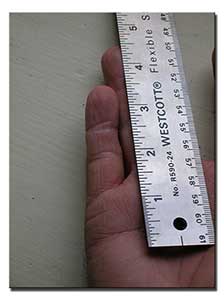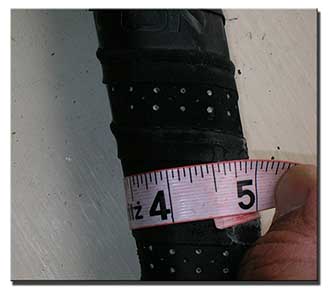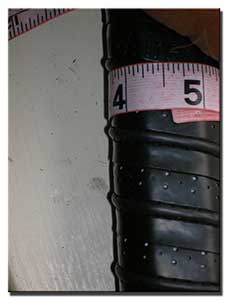How To Choose the Right Grip?
Get a Grip: Understanding How Grips Can Affect Your Game
With all the attention given to high-tech frame designs and the latest tour string trends, tennis players have, for years, shortchanged one of the most important parts of their racquets: the grip. By understanding what it can do for you and how to choose them correctly, you can make a major impact on your game and help prevent injury.
Why Care?
Why should you care about your grip or its size? It's the main line of communication between you and your racquet, for one, and it has a great deal to say about the health of you arm, for another. Picking properly, and maintaining your choices, should be of vital importance.
Improperly sized grips can cause a myriad of problems for your game. Having to squeeze your grip too tightly to overcome a grip that is too small can prevent you from creating enough racquet speed, power and spin on your shots. It can also reduce touch and feel at net, causing the grip to wear out sooner. Working too hard to hold a small handle is one of the main causes of tennis elbow and other arm problems.
While the issues presented by an oversized grip are not as severe, they exist. For instance, having to strain your fingers to hold a "supersized" handle can strain muscles in the forearm and hand and also make it more difficult to change grips between strokes.
By the way, please ignore the reports about pro players using smaller grips to allow faster racquet speeds and quicker grip changes. Players like Federer and Nadal can get away with such things because, well, they're Federer and Nadal! The rest of us need the right grip size for arm health and better shot production.
Choosing a Grip
Almost every replacement grip made today has a polyurethane or leather outer layer, providing color and tackiness (and possibly a raised rib or other texture), and a foam inner layer with padding and moisture absorption properties. They part company in how, and in what amounts, these details are executed.
Manufacturers make different styles of grips to accommodate different player preferences and playing styles. Many advanced players prefer the firmer feel of natural leather grips like the Wilson Natural Leather or Head Leather Tour. Those with arm problems will most likely prefer a cushioned grip like the Gamma Hi-Tech Gel or Wilson Comfort Hybrid (these padded grips can increase handle size), while players who sweat profusely will like an absorbent, or "dry", grip, such as Dunlop's ViperDry or Gamma's RZRDri. If you don't sweat much, or play in drier climates, a tacky replacement grip like the Dunlop Gecko-Tac or Gamma RZR Tac may just fill the bill. If you have a weak hand, a ribbed replacement grip can give you pre-made "finger holds" for improved gripping strength (check out the Wilson CushionAire Contour and Prince ResiRib+). If you use an overgrip and don't want your grip size increased, many companies now produce thinner replacement grips, like the Babolat Skin Feel, Tourna Pro Thin or Prince ResiThin.
You can also find similar qualities in the large number of overgrips available today. Babolat's VS Original overgrip is one of the thinnest made, while the Gamma RZR Tac, Head Prestige Pro, and Prince ResiPro overgrips are slightly thicker (with much more tack). Dunlop's Viper Dry and Gamma's RZR Dri overgrips provide superior absorption. There is even an overgrip with a foam rib for better finger placement in Yonex's Wave Grap.
Finding Your Grip Size
Refers to the width of the racquets beams, and is an indicator of racquet stiffness and power. A racquet with wider beams will tend to flex less than one with more narrow beams (all else being equal), and as such will lose less energy to that flex and transfer more power to the ball. Cross section width is generally measured in millimeters, and is normally termed in the following groups: Control frames will generally have beam widths of 22mm or less, Tweener racquets will usually have beam widths of 23-27mm, and Power frames will tend to have the highest cross sections of 28mm and above.
Flex
There are two ways to determine your proper grip size. The first method involves placing a ruler on the palm of your racquet hand (right, if you're right-handed), on the lower crease across the middle of the palm, and measuring the distance from that crease to the end of your ring finger (see photo #1). In this instance, the player should use a grip size of 4 1/2 inches. Then, see if your racquet's grip size matches. If you determine your grip size is incorrect, before running off to the pro shop, see if your current replacement grip is still in good working order, or if some simple changes we'll recommend below could save you from buying a new stick.
The second, and best, way of checking your grip size involves actually holding your racquet. Hold the racquet as you normally would for any shot you choose, and notice the gap between your fingers and the heel of your hand (if you don't see one, you're already in trouble!). Take the index finger of your non-playing hand and insert it into the gap. If the index finger barely fits (minimal touching of the fingers and heel of hand), you can feel confident your grip size is correct. If there is a noticeable lack of (or no) space, the handle is likely too small; if you cannot touch the fingers or heel of your hand, you most likely have too large a grip. Once again, check below for some options before tossing your racquet.

Quick Fixes
Months or years of use will compress the padded layer of any grip. And a newer-looking outer layer doesn't necessarily mean your grip is in good shape (using an overgrip doesn't help; see below). After using a measuring tape to determine your racquet's grip size, see if it matches the size noted on the shaft (or under the grip). If your grip is improperly sized, there are 3 simple ways to change it.
Overgrips are the cheapest and easiest way to add size. Thin overgrips will add very little to grip size, but may be enough if you're close. Thicker, cloth-style overgrips like Tourna-Grip can add almost one full handle size. A problem with thicker overgrips is their "rounding" effect. You will lose some feel for the bevels on the handle, which could hinder grip changes. Thicker overgrips can also add up to 1/2 oz. to racquet weight.
It may be quite easy to change your grip size by selecting a grip that is thicker or thinner than your current one. Grip "build-up effects" can vary widely: you can actually change handle size by as much as 5/16" (two and one half sizes)! This would have a minimal change in handle shape and racquet weight. However, make sure you like the resulting feel and shock absorption qualities. Check above for examples of thicker and thinner replacement grips.
Heat shrink sleeves like our RAB Tubex let you control the amount of size increase and maintain handle shape. Most sleeves add one full size; some only 1/2 size. Their complete adherence to the handle maintains the bevels for sure grip changes although they, like thick overgips, can add up to 1/2 oz. to overall racquet weight. Installation of these sleeves does require a heat gun. You can do it yourself, or enlist the aid of a professional racquet technician for the best results.
Myth Busted
Let's take some time now to dispel the biggest "tennis myth" to come along in years: "I don't need to change my grip because I use an overgrip."
Every time you swing your racquet, your hand or hands squeeze down on the grip, compressing its padding. Initially, this is imperceptible. However, over a period of time, this compression reduces handle size and lessens shock absorption. Overgips do nothing to prevent this. Photo Two shows an old grip and the resulting handle size it creates. Photo Threeshows the same racquet with a new grip of the same type, and a full 1/8" larger handle size.
To ensure yourself of proper grip size, replace your grip at least twice a year, and preferably with every stringing, even if you use an overgrip.


Changing Brands
If you change your racquet brand, it may not be best to simply purchase the same size as before. Believe it or not, not all grips are the same. A Wilson 4 1/2 handle, for example, will normally "feel" larger than a Head one, due to the difference in handle shape. Some handles actually are sized differently, depending on the thickness of the grip covering them. This is why it's a good idea to consult a knowledgeable professional (or our Tennis Express staff) before ordering a new stick.
Conclusion
Too few tennis players think about the grips on their racquets. Making sure your grip size is correct, making changes as needed, and exercising proper maintenance of the grip can make stroke production easier, ease or eliminate arm problems, and give you the upper hand in your matches. So, "get a grip" on your racquet today!
To learn how to install a grip, make sure to check out our blog/video HERE!


